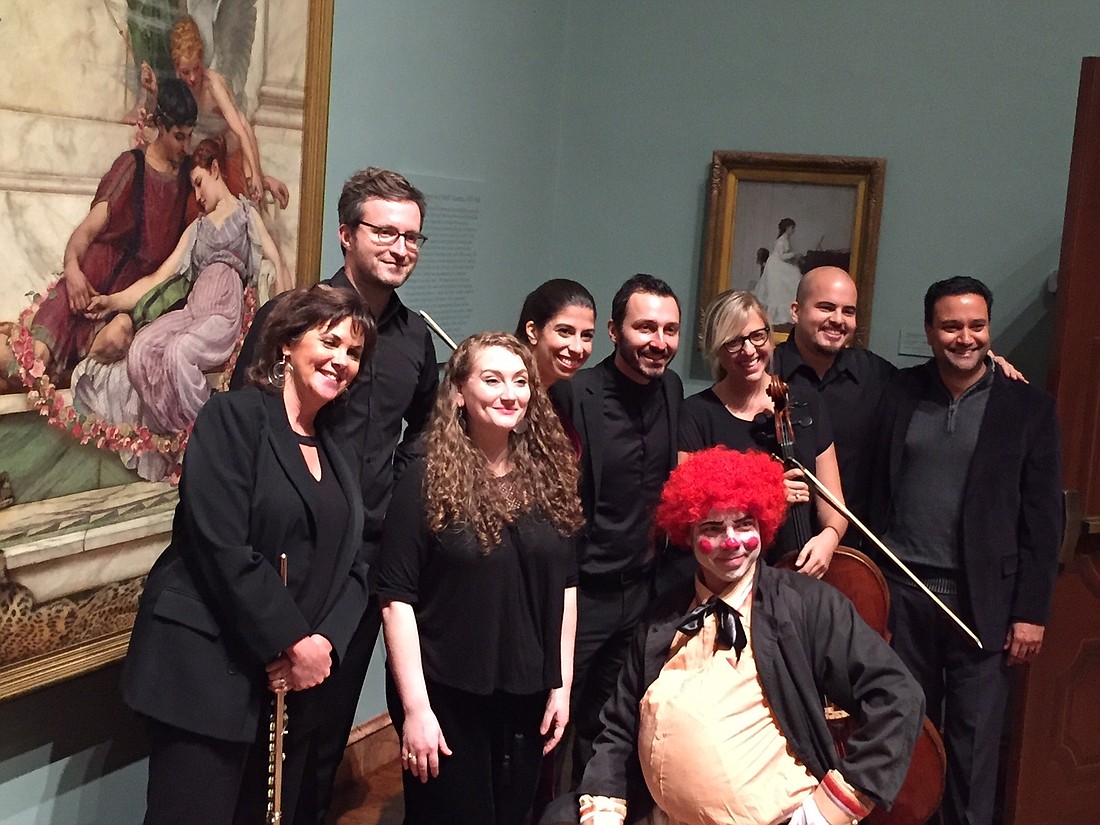- November 25, 2024
-
-
Loading

Loading

For eight years, the Ringling International Arts Festival has continued to provide performances that are both innovative and provocative, and in the recently concluded ninth season, held Oct. 18-21, Performance Curator Dwight Currie has done it once again, especially in his choice of musical performance.
ensemblenewSRQ, established by Sarasota Orchestra musicians Samantha Bennett and George Nickson, is only in its second season, but it has already proved itself worthy of participation in an international festival. Using primarily outstanding local musicians, the group presented two programs at the festival.
The first, held in the James Turrell Skyspace in the Searing Wing of the Museum, was an experience and exercise in sonic immersion, featuring two works: Salvatore Sciarrino’s “Codex Purpureus” and “Four Thousand Holes” of John Luther Adams.
The Turrell Skyspace provided an aural enhancement for both works, starting with Sciarrino’s more intimate “Codex,” played by Samantha Bennett, violin, Steven Laraia, viola, and Natalie Helm, cello. Ranging from barely audible harmonics to slashing forte outbursts, the work seemed to set the stage for the more dynamic and dramatic piece that followed.
For those of us who are interested in giving our musical horizons a good stretch, we can do no better than these two world-class performances.
“Four Thousand Holes” is a venture into the realm of acoustic tolerance, surrounding us with an electronic drone that varied from a faint whisper to the edges of decibel drowning. Building on this base of sound, pianist Conor Hanick and percussionist George Nickson interjected sounds ranging from chime-like chords ringing through the piano, to seemingly random percussive passages on both glockenspiel and vibraphone. The overall effect was indeed one of being surrounded and at times almost drowning in the sound, which traveled several times around the Turrell space before being lofted upward through the Skyspace opening, and ending with a whisper, with the audience taking a few moments of recovery time before bursting into applause.
Program Two was devoted to the music of Luciano Berio, one of the giants of 20th century experimental and electronic music. Berio’s “Sequenzas” is a series of 14 works for solo instruments and voice, both as a tribute and challenge to the expressive possibilities and extreme limitations of each instrument. The Huntington Gallery of the Ringling was the chosen site for this program of virtuoso performances, and its live acoustic served to enhance their stereophonic effect.
To describe the technical skill, artistry and performance of each of the players (Brad Williams, trombone; Samantha Bennett, violin; Bharat Chandra, clarinet; Thea Lobo, mezzo soprano; and Conor Hanick, piano) would be as formidable a task as their performances of this most difficult set of works. All were outstanding, from Williams, dressed as a clown, tromboning his way through the audience, and Lobo, testing the extremes of the human voice, to the sonic and physical tour de force of pianist Hanick. Every work presented us with a new musical challenge.
Chandra provided a bit of musical repose with his solo performance of Berio’s “Lied,” while quietly strolling through the audience with soothing and beautiful sounds. The program was given musical bookends with two movements from Berio’s “Musica Leggera,” charmingly played by Betsy Traba, flute, Helm, cello, Steven Laraia, viola and Nickson, tambourine, stationed in the four corners of the gallery.
Sarasota has an ever increasing audience for contemporary music, as evidenced by the excellent attendance at these and other such offerings in our city. Even though for some it may be a very much acquired taste, for those of us who are interested in giving our musical horizons a good stretch, we can do no better than these two world-class performances.
RIAF’s other musical offering was “Nobuntu,” five women singers from Zimbabwe, who presented traditional Zimbabwean selections, as well as some gospel and crossover. Colorfully costumed and performing a cappella with occasional subtle rhythmic drumming accompaniment, their perfectly blended voices harmonized to provide an uplifting and moving performance. Ranging from audience participation with rhythmic clapping and clicking to their own songs of a more personal nature, physical and mental abuse, they provided a musical message which was not lost on the audience. A most unusual and beautiful arrangement of "Amazing Grace" closed their final performance Saturday afternoon.